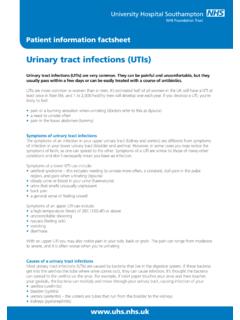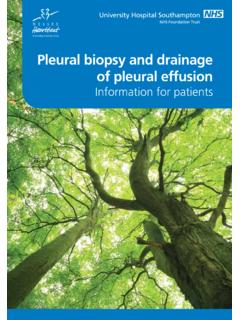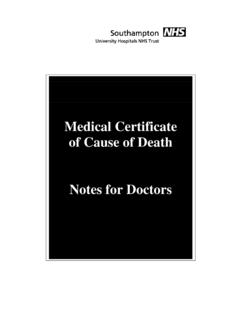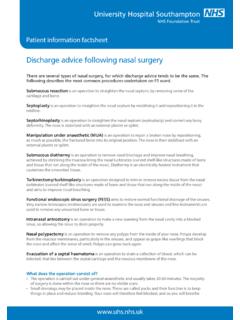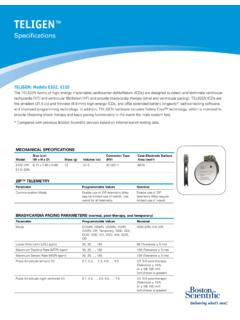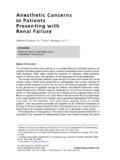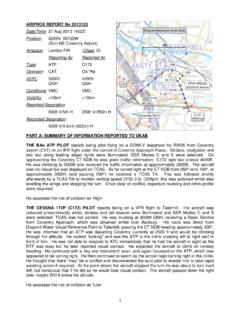Transcription of Implantable cardioverter defibrillator (ICD) - UHS
1 Patient information information factsheetImplantable cardioverter defibrillator (ICD) The normal electrical system of the heart The heart has its own electrical conduction system. The conduction system sends signals throughout the upper chambers (atria) and lower chambers (ventricles) of the heart to make it beat in a regular, coordinated rhythm. The conduction system consists of two nodes that contain conduction cells and special pathways that transmit the normal heartbeat begins when an electrical impulse is fired from the sinus node (also called sino-atrial or SA node), in the right atrium.
2 The sinus node is responsible for setting the rate and rhythm of the heart and is therefore referred to as the heart s pacemaker. The electrical impulse fired from the SA node spreads throughout the atria, causing them to contract and squeeze blood into the ventricles. The electrical impulse then reaches the atrioventricular node (AV node), which acts as a gateway, slowing and regulating the impulses travelling between the atria and the ventricles. As the impulse travels down the pathways into the ventricles the heart contracts and pumps blood around the body.
3 The cycle then begins again. A normal adult heart beats in a regular pattern 60 to 100 times a minute; this is called sinus rhythm. Diagram of the heart s electrical systemArrhythmiaSometimes, if the conduction pathway is damaged, blocked, or an extra pathway exists the heart s rhythm changes. The heart may beat too quickly (tachycardia), too slowly (bradycardia) or irregularly. This may affect the heart s ability to pump blood around the body. These abnormal heartbeats are known as arrhythmias. Arrhythmias can occur in the atria or in the of hisSA nodeRight atriumAV nodeRight ventricleRight bundlebranchLeft atriumLeft ventricleLeft bundle branchPurkinje fibersPatient information cardioverter defibrillator (ICD)Your doctor has decided that you must have an ICD implanted as you have either survived a cardiac arrest or are considered to be at risk of developing a potentially life threatening heart rhythm.
4 The ICD will treat the fast impulses from the ventricles, by either pacing you out of your fast rhythm or by delivering shock therapy. Although this is not pleasant it is lifesaving. The ventricular arrhythmias you are considered to be at risk of developing are ventricular tachycardia (VT) and ventricular fibrillation (VF).VT occurs when the ventricles start beating at an abnormally fast rate. This effectively creates an electrical short circuit within the ventricular muscle. As the ventricles are beating rapidly the heart does not work as efficiently as it does during normal sinus rhythm.
5 This can cause you to experience feelings of weakness, dizziness, chest pain, shortness of breath or may even cause you to collapse. VT is often found in people who have previously had a heart attack. The area of the heart muscle damaged by the heart attack forms scar tissue, which makes the heart susceptible to abnormal heart rhythms such as VT. Other causes of VT are: Cardiomyopathy, a progressive thickening of the heart muscle. A family history of sudden cardiac death due to an inherited arrhythmia, such as long QT syndrome or Brugada syndrome.
6 The underlying fault may be due to changes within the cells of the heart (ion channels). Ion channels alter the chemical balance of the cardiac cells. By adjusting the amount of electrical charge to them this can result in a disturbance of the heart rhythm (arrhythmia).There is also a small group of people who have VT despite having a structurally normal heart. After you have had all the necessary investigations, your doctor will be able to explain the likely cause of your VT to people do not experience any symptoms and are unaware of their arrhythmia.
7 However, in some people if VT is left untreated it may lead to a more life threatening condition called ventricular fibrillation (VF) is more serious than VT because it can result in sudden death if not treated immediately. With VF the heart s electrical and pumping systems are completely disorganised, and the heart provides little or no blood flow to the body resulting in loss of consciousness and cardiac tests It is likely that your doctor will suggest you have a number of tests before the decision is taken to implant an may need to have a test called a ventricular tachycardia stimulation test (VT stim) or an electrophysiology study (EPS).
8 These tests allow your doctor to consider your individual risk of developing VT or VF by inducing your arrhythmia in the controlled environment of the catheter lab. Your doctor can then assess whether or not you would benefit from having an ICD implanted. In some people VT or VF is not inducible during the test, but your doctor may still advise that you need an ICD. This is to protect you if your doctor thinks there is still a significant risk of you developing a ventricular arrhythmia in the may also have an angiogram (cardiac catheter) to check the blood supply to the heart.
9 Due to a blockage or narrowing in one of the coronary arteries (blood vessels that supply the heart) you may have a reduced blood flow to the heart. This can cause ischaemia (lack of oxygen to the heart muscle) Patient information can cause arrhythmias. If the blockages or narrowings can be treated by angioplasty (inflation of a balloon catheter to widen the narrowed artery) or by cardiac surgery, you may no longer be at risk of developing arrhythmias as normal blood flow is returned to the patients will need to have a magnetic resonance imaging (MRI) scan to look in a very detailed way at the structures and muscle of the heart.
10 After you have had an ICD implanted you will not be able to have an MRI scan, due to the large magnet contained within the scanner. You will still be able to have a CT who are suspected of having an inherited arrhythmia called Brugada syndrome will have an ajmaline test. Ajmaline is a drug known as a sodium channel blocker. Ajmaline blocks the faulty sodium channels and unmasks electrocardiogram (ECG) changes in those patients who have Brugada. In patients with normal cardiac cells ajmaline has little or no effect on the ECG.



